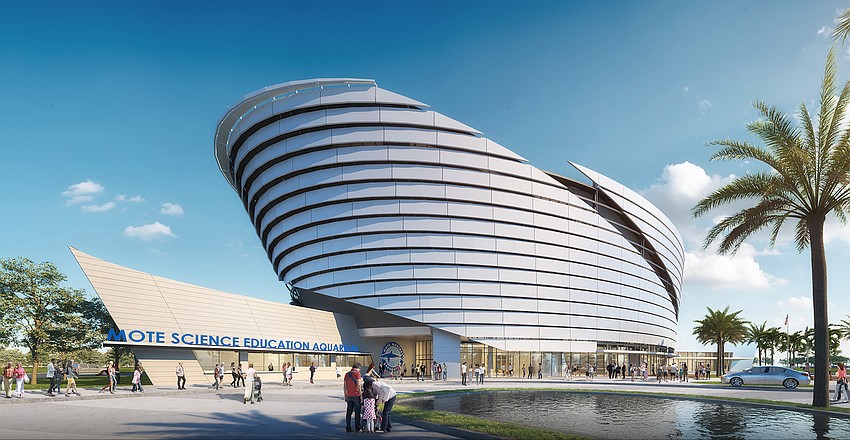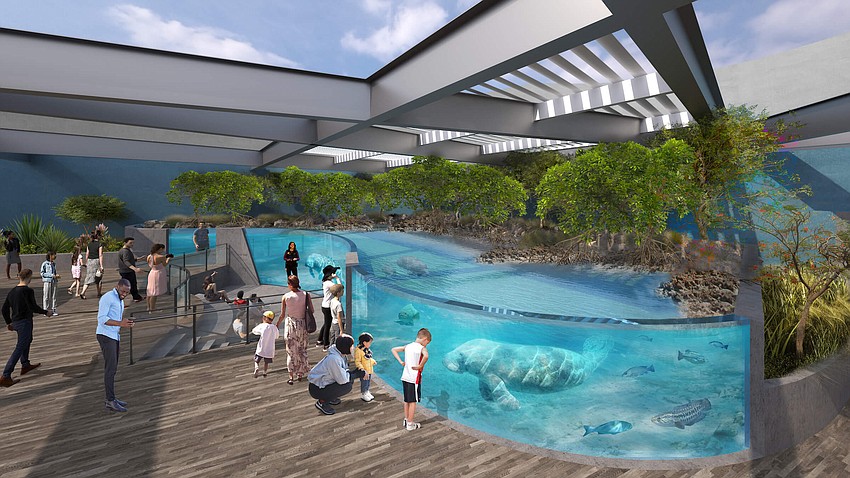- May 30, 2025
-
-
Loading

Loading

Passersby at the construction site of the new Mote Science Education Aquarium can’t help but notice the $132 million facility taking its ship-like shape just west of I-75 near University Town Center.
Extending from the northeast-facing elevation are the angled supports essential to the building's artistic form of a ship — a great ark that, rather than being surrounded by sea life, will contain it within.
When complete, the Mote SEA expects to be flooded with visitors. First-year attendance is projected to be upwards of 700,000.
Last week, Mote Marine secured $20 million in funding by unanimous vote of the Sarasota County Commission, the reimbursement resolution including a $16 million borrow that will be paid for from revenues generated by Surtax VI, the 1/6th penny sales tax approved by countywide referendum.
The commitment of $20 million will be provided partially in cash funded by previous tourist development tax collections, estimated to be $4 million, with the $16 million balance from net bond proceeds. The bond will be issued using TDT as a pledge and the debt service covered by TDT collections.

The bond will be issued for a 20-year period with an annual debt service of approximately $1.1 million with total debt service of approximately $23.9 million. As of July 2023 the Mote SEA had funding commitments in excess of $100 million.
Discussions about financial support for the new aquarium on nearly 12 acres of formerly county-owned property between UTC Mall and Nathan Benderson Park began in fall of 2018. That’s when Mote Marine Laboratory & Aquarium announced its intention to move the aquarium from City Island between St. Armands and Longboat keys to its new, higher-profile location.
Vertical construction began in the summer of 2022 and the build is progressing toward its planned completion in late 2024.
"If you're driving by there, it's no secret anymore that this is out of the ground,” Mote Vice President for Communications and Strategic Initiatives Kevin Cooper told commissioners. "We're starting to pull scaffolding out. All of the concrete is cured. We anticipate coming for a CO (certificate of occupancy) in August or September of 2024. We can start putting water in before that, but we can't move any animals into the facility until we get our CO. We have strict quarantine procedures that are necessary due to our accreditation, so we anticipate doing some soft openings sometime in December of 2024.”
Cooper said the hope is for the Mote SEA to open its doors to the public by Jan. 1, 2025.
As the only sitting county commissioner serving since the beginning of the aquarium planning, Moran was given the opportunity to make the motion to finalize the county’s contribution.
“It was an honor watching this come from a conceptual, visionary discussion with colorful renderings — some would maybe even argue wishful thinking — to all of a sudden we are way beyond that,” Moran said. “It's just truly amazing.”
The centerpiece of the aquarium is the three-story, 400,000-gallon Gulf of Mexico shark habitat, which is among exhibits totaling more than 1 million gallons, and will feature an array of sharks, Atlantic and Pacific coral reef species, manatees, sea turtles, otters and other wildlife. Interactive labs and hands-on classrooms will be accessible to all schools in the region, including opportunities at no cost.
The Mote SEA will nearly double Mote’s aquarium space from its current 66,000 square feet on City Island to 110,000 square feet. It will also allow Mote to transform its City Island campus into an enhanced international marine science, technology and innovation park.

“I always like to remind people when we started with this conversation the intent back then is that City Island will be an economic driver and career creator for the scientists,” Moran said. “I'm sure a lot of attention and money will be put into City Island to bring about real high-paying jobs that will draw people from all over the world. So while the aquarium gets a lot of attention, the science mission behind Mote is just going to be truly amazing.”
Commissioner Joe Neunder asked if the Mote SEA will offer a literal immersive experience with the sea life contained in the new facility.
“One thing I'm looking forward to the most is the 70,000 students who are going to be coming free of charge every year to the science education aquarium for educational experiences,” Cooper said. “Those who are dive certified will be able to get behind the scenes and actually get in the tanks. It’s one thing to show people something, but we know the closest and the best way to educate people about the importance of marine science conservation and sustainable use is to bring them as close as possible to it. There is no better way to get them educated on this than to put them in the water.”
For everyone not swimming with the sharks, Mote SEA will offer general admission and day passes, and will host three STEM teaching labs for students in nearby school districts. There, Mote’s scientists plan to provide education about marine life, challenges affecting the ocean and their various research around the world.